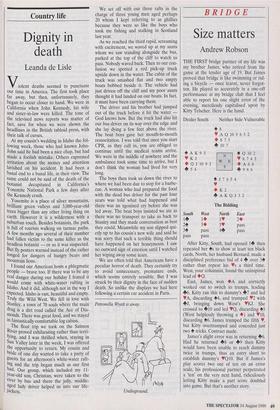BRIDGE
Size matters
Andrew Robson
THE FIRST bridge partner of my life was my brother James, who retired from the game at the tender age of 19. But James proved that bridge is like swimming or rid- ing a bicycle — once learnt, never forgot- ten. He played so accurately in a one-off performance at my bridge club that I feel able to report his one slight error of the evening, mercilessly capitalised upon by Kitty Telscher. Here is the hand.
Dealer South Neither Side Vulnerable 4 8
• A Q 10 9 6 5 2 + A K 9 • K J • Q J 10 +54 3 9 3 •
4
V
8 7 5 10 7
4 C) 10 2 V 8 7 4 3 • A 6 4 4 9 8 6
4
N
W E
J 7 6 5
• K 2 + AKQJ 3 2
The Bidding South West North East 1* 1V 2* 24 3* 3, pass 34 pass 4+ pass pass pass After Kitty, South, had opened 14 then repeated her 4s to show at least ten black cards, North, her husband Bernard, made a disciplined preference bid of 4 + over 34 rather than repeat his Vs a third time. West, your columnist, found the uninspired lead of *Q.
East, James, won *A and correctly worked out to switch to trumps, leading +6. Kitty ran this to dummy's 47 and led VA, discarding 44, and trumped V2 with 4J, bringing down West's !KJ. She crossed to +10 and led VQ, discarding 45 (West helplessly throwing a *) and V10, discarding 46. James trumped the fifth V, but Kitty overtrumped and conceded just two 4 tricks. Contract made.
James's slight error was in returning 46. Had he returned +8 or 49 then Kitty would have been unable to reach dummy twice in trumps, thus an entry short to establish dummy's VQ10. But if James's play scores two out of ten on an error scale, his professional partner perpetrated a 'ten' on the very next hand, ridiculously letting Kitty make a part score doubled into game. But that's another story.


























































 Previous page
Previous page